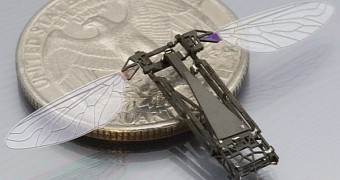The Robobees at Harvard are one fancy lot. They fly around hovering like their real organic counterparts in calm air, but they do one thing extra compared to their biological cousins: they can swim as well.
The size of paper-clips, the Robobees fly around while tethered to power like some real bees. However, in times of need they have one extra skill compared to the real insects, they can swim. In order to do this properly, the insects transition from flying to going underwater by crashing into the liquid, sink for a second or two and their flap their wings at a much slower pace (9 Hz) than in the air (120 Hz).
At the moment, there are a couple of drones in development by the U.S. Navy that can do both, but to actually do this thing while being the size of a bee brings things to a whole new level of stealth. In fact, the size feature is so effective that it poses major issues to researchers that currently do not possess any batteries small enough to fit on the electronic bees and keep them flying along.
Additionally, the bees are so light that they need extra lubrication to break the water surface when they land and swim, and reversibly when they attempt to fly again after spending some time under water.
Although these issues are pretty much solved at the moment, another problem that scientists need to solve as soon as possible is to help the little mechanical bug fly in a stiff wind like its real counterparts. Once this is done, together with a much more advanced battery, these little insects will simply be undetectable and there won't be any escaping from them.

 14 DAY TRIAL //
14 DAY TRIAL // 